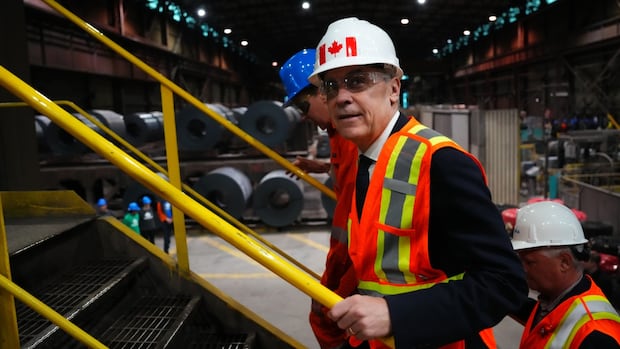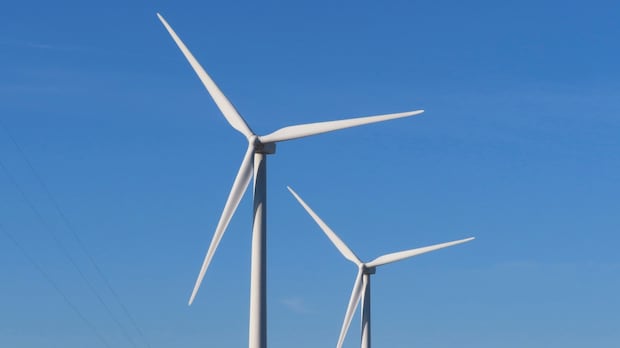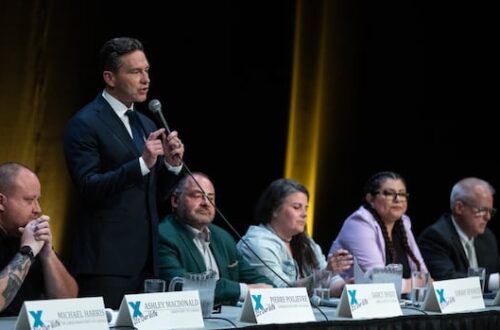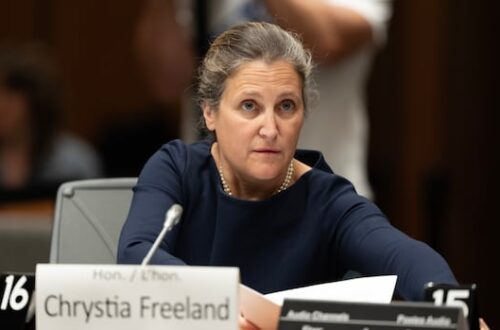On a gravel road by the side of the Trans-Canada Highway, New Brunswick’s natural resources minister, John Herron, gazes down a long clearing cut through the forest.
He sees poetry — national poetry, that is.
Herron hopes one of New Brunswick’s proposed “projects of national interest” will connect to an existing natural gas pipeline running under that clearing.
“This is a nation-building project that checks every box,” Herron says.
The plan is to extend a gas line that now ends in Quebec City into New Brunswick to link with the Maritimes and Northeast Pipeline beneath the minister’s feet.

The line carries Alberta gas routed through the United States, or gas extracted in the U.S., into Atlantic Canada.
But the Quebec extension would bypass American territory completely, creating an all-Canada route.
“The poetry kind of goes like this: You have Western Canada gas going into Ontario, through the province of Quebec, [by] adding additional pipe from Quebec City into Atlantic Canada,” the minister says.
“That additional pipe, aspirationally speaking, would be made of Ontario steel.… This is a made-in-Canada solution. This is energy sovereignty.”
The proposal is on New Brunswick’s list of projects submitted to Mark Carney’s government for expedited regulatory approval under Bill C-5, which was adopted into law in June.
Carney underscored his own build-Canada agenda again on Friday, after the deadline passed for a trade agreement with the U.S. and U.S. President Donald Trump raised tariffs on many Canadian exports.
“Canadians will be our own best customer,” Carney said in a statement.
The Eastern Energy Partnership
The prime minister’s call for proposals has stirred interest from provincial governments across the country, not least in Atlantic Canada, where premiers see a new opportunity to boost their economies and meet a growing demand for electricity.
Many of their proposals fall under the label of the Eastern Energy Partnership, which envisions the four Atlantic provinces generating more electricity and transmitting it to each other, to Quebec and to other buyers.
They range from upgrading the subsea cable between Prince Edward Island and the New Brunswick mainland — likely one of the quicker, simpler projects — to a Nova Scotia proposal to build enough offshore wind turbines to generate a quarter of Canada’s electricity needs.
Winning the “project of national interest” designation gets proponents a faster regulatory review process but doesn’t guarantee federal funding.

It’s also not a sure thing that Ottawa will approve the Eastern Energy Partnership projects as a whole.
“I don’t want the perfect to be the enemy of the good,” says Nova Scotia Liberal MP Sean Fraser, the minister responsible for the Atlantic Canada Opportunities Agency.
“I think we have an opportunity — and in fact an obligation — to move as quickly as possible on the components of the partnership that are ready,” he says.
Many of the projects face obstacles.
Bill C-5 has provoked a skeptical reaction from some First Nations leaders concerned that accelerated reviews will compromise their right to be consulted.
In New Brunswick, however, some chiefs are open to making deals.
Pabineau First Nation Chief Terry Richardson supports the New Brunswick government’s proposals, which include an expansion of nuclear power generation in the province.
“I’m OK with it, because we need a solution. We need a baseline source of energy and right now we don’t have any,” says Richardson.
“I mean, renewables are great, but what do you do when the wind don’t blow, the sun don’t shine, and the water don’t flow?”
Assembly of First Nations regional chief Joanna Bernard says many bands are keeping an open mind but will insist on equity stakes in projects.
“Back in the day, it was ‘Here’s some scholarships,’ or ‘Here’s capacity building so maybe your people can work on the pipeline.’ Those days are gone,” Bernard said.
“We’re going to own part of the company. We’re going to be there on the ground, making sure environmental issues are of the highest priority. And the profits will go to the First Nations.”
Wind and nuclear power
Nova Scotia Premier Tim Houston’s Wind West plan to develop thousands of offshore turbines and export the electricity to other provinces could be a boon for national efforts to decarbonize its power sources, if it came to fruition at that scale.
Scott Urquhart, the Cape Breton-born CEO of a Copenhagen-based wind energy company, says the project is doable, with the wind off Nova Scotia being “pretty much best in the world.”
Nova Scotia Premier Tim Houston has plans to license enough offshore wind farms to produce 40 gigawatts of electricity — which could supply 27 per cent of Canada’s total electricity demand. But what will it take to get there? The CBC’s Tom Murphy spoke with Thomas Arnason McNeil of the Ecology Action Centre.
But it may take a decade or more to get turbines turning, and at a considerably higher cost than the $5 to 10 billion the premier is forecasting, according to Halifax energy consultant Heidi Leslie.
“The estimate is really low,” she says.
Wind power prices in a recent U.S. bidding process were far higher than what Ontario customers are now charged on their residential power bills, Leslie says.
At that rate, “you’re losing money on every kilowatt” from Wind West, she says.
“And the further away it is from the place that’s using it, the more expensive it is, because you need to build the transmission to get it there.”
New Brunswick and Nova Scotia are doubling their transmission links, but “that will certainly not be enough to handle what is required,” says Larry Hughes, an energy expert at Dalhousie University in Halifax.
WATCH | Nova Scotia Premier Tim Houston’s ‘Wind West’ video:
New Brunswick’s ambition to expand nuclear generation is also provoking questions.
The province’s existing nuclear power plant, Point Lepreau, has been plagued with costly problems since it began operating in 1983. It is responsible for a large part of the provincial power utility’s $5-billion debt.
More nuclear power — whether that is a second large reactor at Point Lepreau or small modular reactors — will only add to the financial burden, says David Coon, leader of New Brunswick’s Green Party.
“It’s insane,” Coon says.
“We all get nuclear power bills of a size that no one is happy with because of the extremely expensive cost of owning a nuclear power plant.”
Affordability top of mind
New Brunswick Premier Susan Holt says she gets it.
Holt won a big majority last year after campaigning on affordability issues, and she’s already faced blowback from residents about their power bills.
She hopes neighbouring provinces will share the expense of more nuclear generation in exchange for some of the electricity that will be produced.
“When I’m trying to deliver affordability for New Brunswickers, I’m looking at who’s shouldering the burden with us,” she says.
“How do we reduce the cost to New Brunswick ratepayers while still pursuing our objectives of clean power and reliable power?”
In addition to nuclear power, New Brunswick’s electricity is generated by a combination of fossil fuels, hydro, and to a lesser extent, wind and biomass.
Without its emissions-free nuclear reactor, the province would need to burn four times as much coal, making it even harder to lower emissions, says Brad Coady, its vice-president of business development.
Meanwhile, the province’s largest hydro dam, Mactaquac, needs a major upgrade that could cost up to $9 billion.
Lori Clark, the CEO of N.B. Power, says there’s an onus on the federal government to help defray the costs of decarbonizing the power supply, rather than passing costs on to customers.

“I do really believe that the federal government has a role to play in this as well. They’ve set the deadlines for net zero,” Clark says.
Herron is also looking for federal support, invoking the possibility of a government ownership stake in the natural gas line extension.
“I think there’s an opportunity to de-risk the project if the project is initially state-owned and First Nation-owned,” he says.
That would speed up permitting “and it de-risks that investment for the private sector at a future date.”
Fraser would not commit to that — but he didn’t close the door either, citing the precedent of the federal government’s 2018 takeover of the Trans Mountain pipeline expansion project in British Columbia.
“More often, the right outcome will be that we create the environment that will incentivize investment, that will allow private companies to set up to succeed and to employ people in the region,” he adds.
“But we don’t want to write off the possibility that certain kinds of investments may be required for particular projects to make them viable if we believe the long-term interests of Canadians will be served.”






